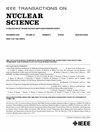硅漂移探测器单片阵列中的电荷共享评估和主动准直
IF 1.9
3区 工程技术
Q3 ENGINEERING, ELECTRICAL & ELECTRONIC
引用次数: 0
摘要
当光子在像素边缘附近被吸收时,像素之间的电荷共享(CS)是基于硅漂移探测器(SDD)单片阵列的 X 射线光谱探测器的一个重要问题。传统的机械准直可减轻 CS,但会减少探测器的有效面积。这对于小像素探测器来说尤其如此,因为机械准直器会遮挡很大一部分有效面积,而且对于小孔径探测器来说,其制造也变得相当复杂。在这项工作中,我们对 SDD 中的 CS 进行了研究,并引入了主动准直法作为机械准直法的替代方法,利用电荷敏感放大器(CSA)输出信号的关键参数,来识别相邻像素中定义的重合窗口(CW)内发生的 CS 事件。为了验证这项技术,我们首先使用聚焦脉冲激光对具有 2 毫米边方形像素的 16 元单片 SDD 模块进行了 CS 影响的定量评估。然后,我们在使用未经准直的 55Fe 源进行光谱测量时,在这种探测器配置上测试了主动准直算法,证明了它在恢复 CS 事件并将其重建为 Mn-K $\alpha $ 峰值事件方面的能力。与机械准直法相比,这种主动准直法不仅增强了有效的有效面积,同时大幅减少了光谱的背景连续波,而且还能恢复未准直探测器因 CS 固有效应而不可避免地丢失的信息。本文章由计算机程序翻译,如有差异,请以英文原文为准。
Charge Sharing Assessment and Active Collimation in Monolithic Arrays of Silicon Drift Detectors
Charge sharing (CS) between pixels is a significant concern in X-ray spectroscopy detectors based on monolithic arrays of silicon drift detectors (SDDs) when a photon is absorbed near a pixel edge. Traditional mechanical collimation mitigates CS but decreases the active area of the detector. This is particularly true for small-pixel detectors, where the mechanical collimator shields a significant portion of the active area and, moreover, becomes quite complex to be manufactured for small apertures. In this work, we carry out a study of CS in SDDs and introduce active collimation as an alternative to mechanical collimation, leveraging key parameters of signals at the output of the charge-sensitive amplifier (CSA), to identify CS events occurring within a defined coincidence window (CW) in neighboring pixels. To validate the technique, we first conducted a quantitative assessment of the impact of CS on a 16-element monolithic SDD module with 2-mm-side square pixels using a focused pulsed laser. We then tested an active collimation algorithm on this detector configuration during a spectroscopic measurement with an uncollimated 55Fe source, demonstrating its capability in recovering CS events and reconstructing them as Mn-K
$\alpha $
peak events. This active collimation approach, in contrast to mechanical collimation, not only enhances the effective active area while achieving a substantial reduction in the background continuum of the spectrum, but also recovers information inevitably lost in uncollimated detectors due to intrinsic CS effects.
求助全文
通过发布文献求助,成功后即可免费获取论文全文。
去求助
来源期刊

IEEE Transactions on Nuclear Science
工程技术-工程:电子与电气
CiteScore
3.70
自引率
27.80%
发文量
314
审稿时长
6.2 months
期刊介绍:
The IEEE Transactions on Nuclear Science is a publication of the IEEE Nuclear and Plasma Sciences Society. It is viewed as the primary source of technical information in many of the areas it covers. As judged by JCR impact factor, TNS consistently ranks in the top five journals in the category of Nuclear Science & Technology. It has one of the higher immediacy indices, indicating that the information it publishes is viewed as timely, and has a relatively long citation half-life, indicating that the published information also is viewed as valuable for a number of years.
The IEEE Transactions on Nuclear Science is published bimonthly. Its scope includes all aspects of the theory and application of nuclear science and engineering. It focuses on instrumentation for the detection and measurement of ionizing radiation; particle accelerators and their controls; nuclear medicine and its application; effects of radiation on materials, components, and systems; reactor instrumentation and controls; and measurement of radiation in space.
 求助内容:
求助内容: 应助结果提醒方式:
应助结果提醒方式:


